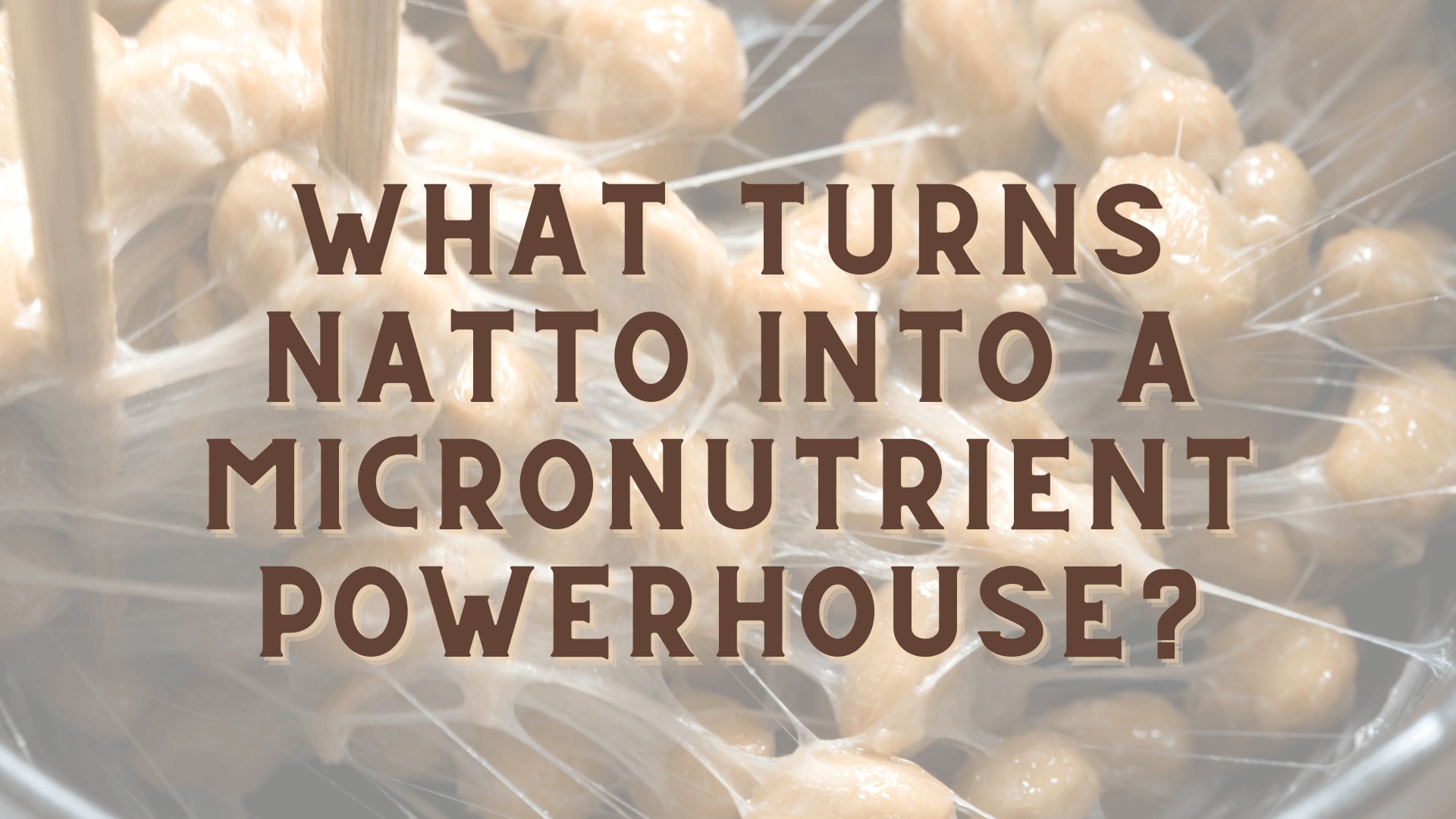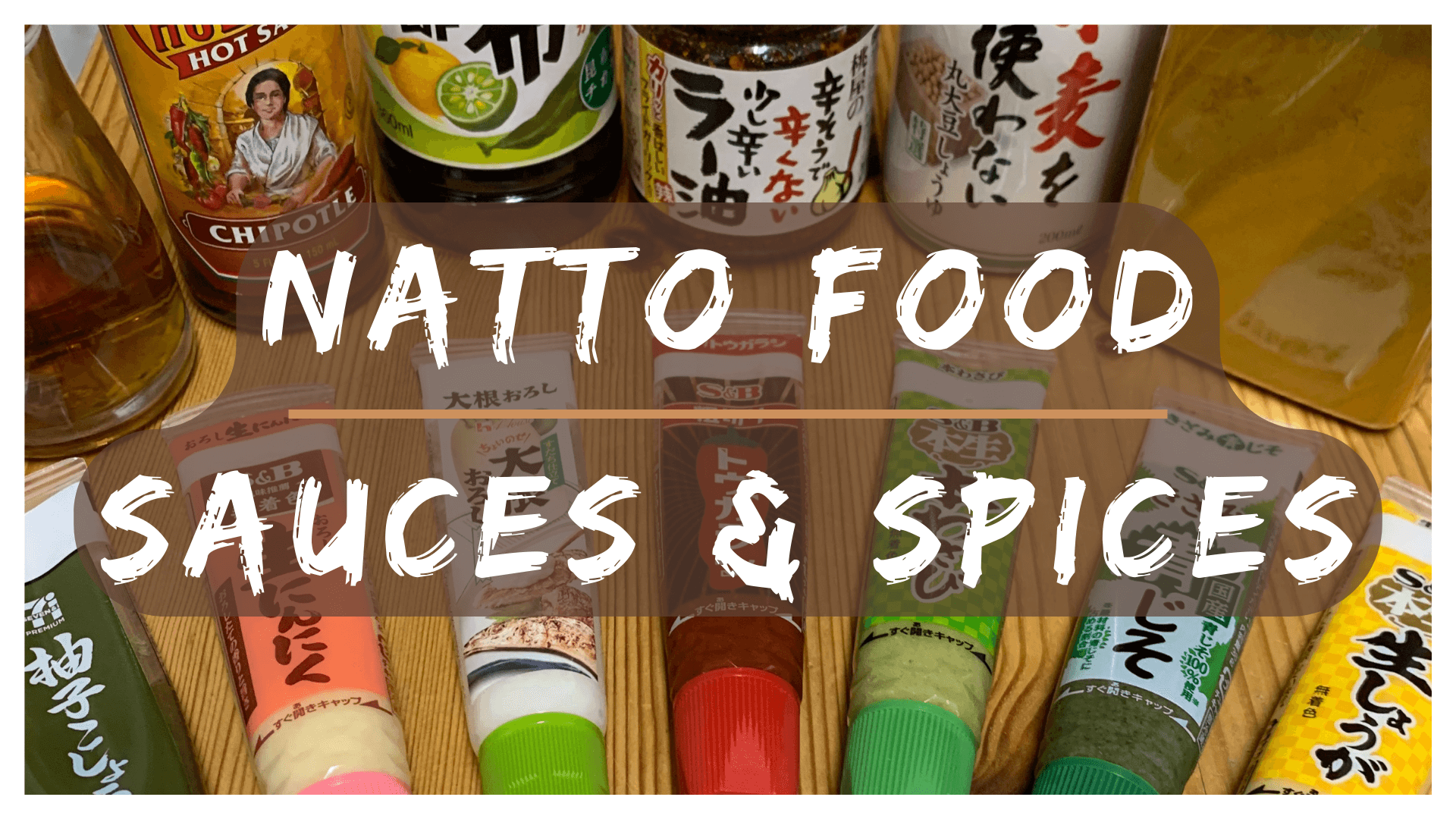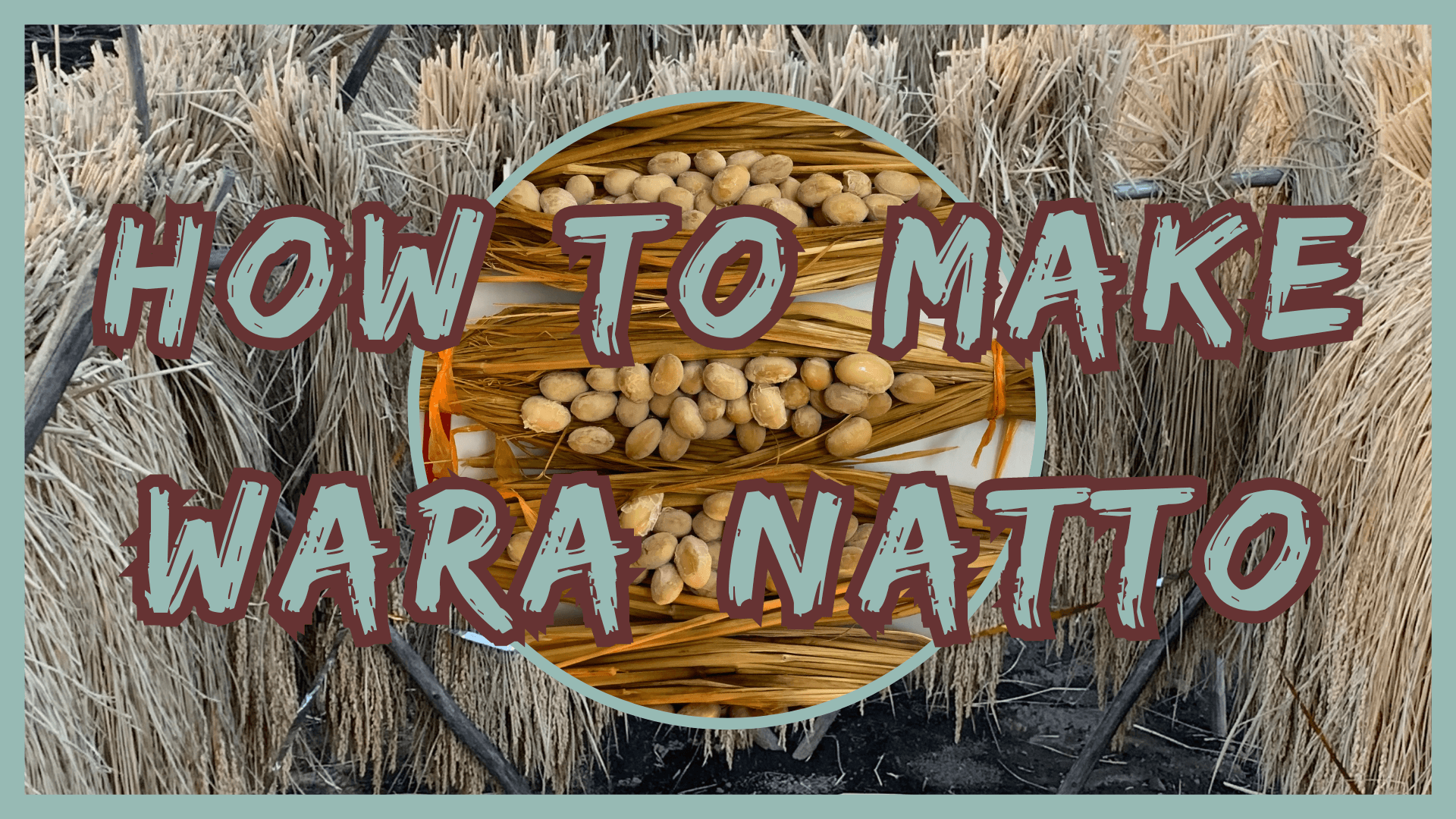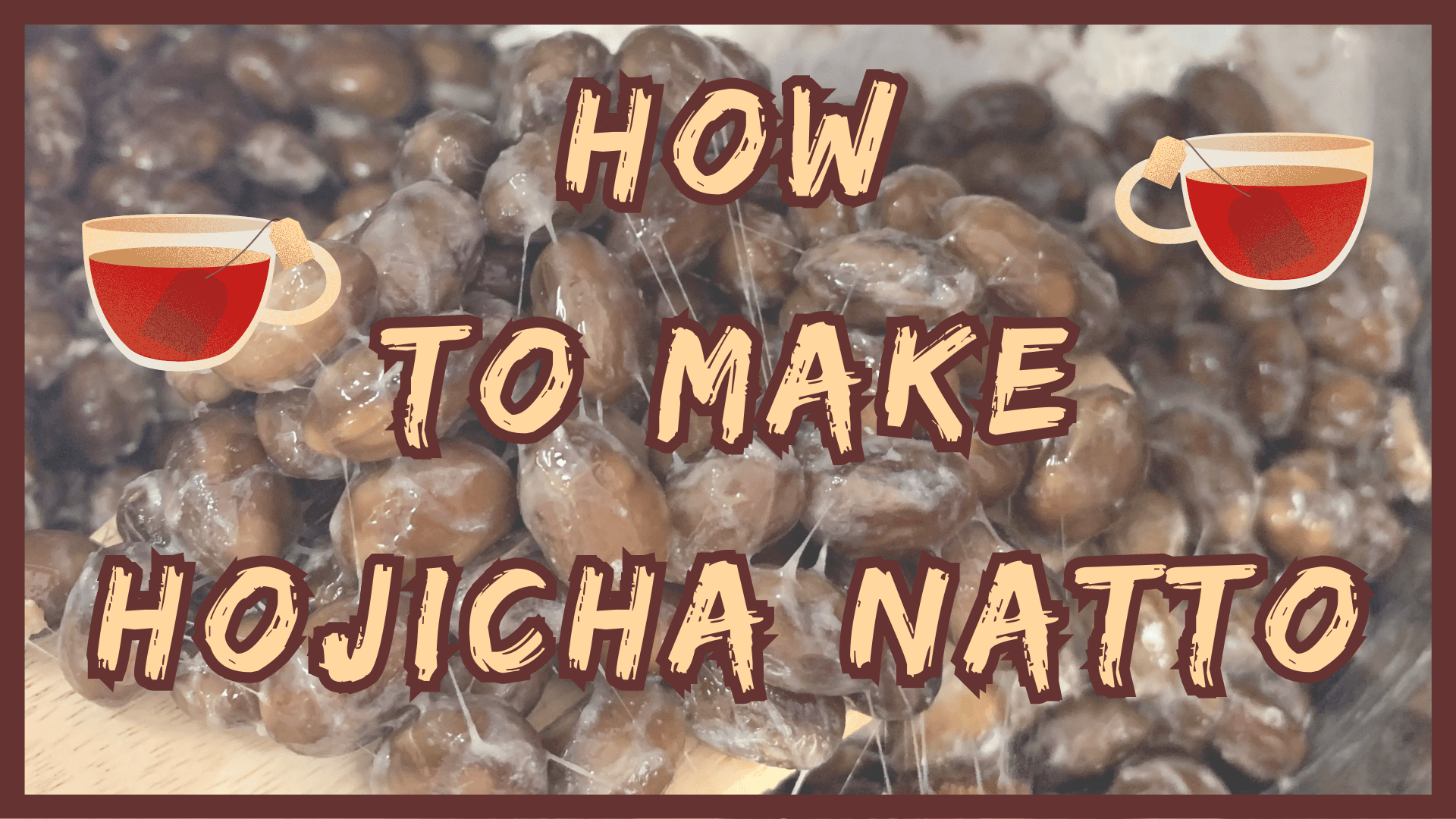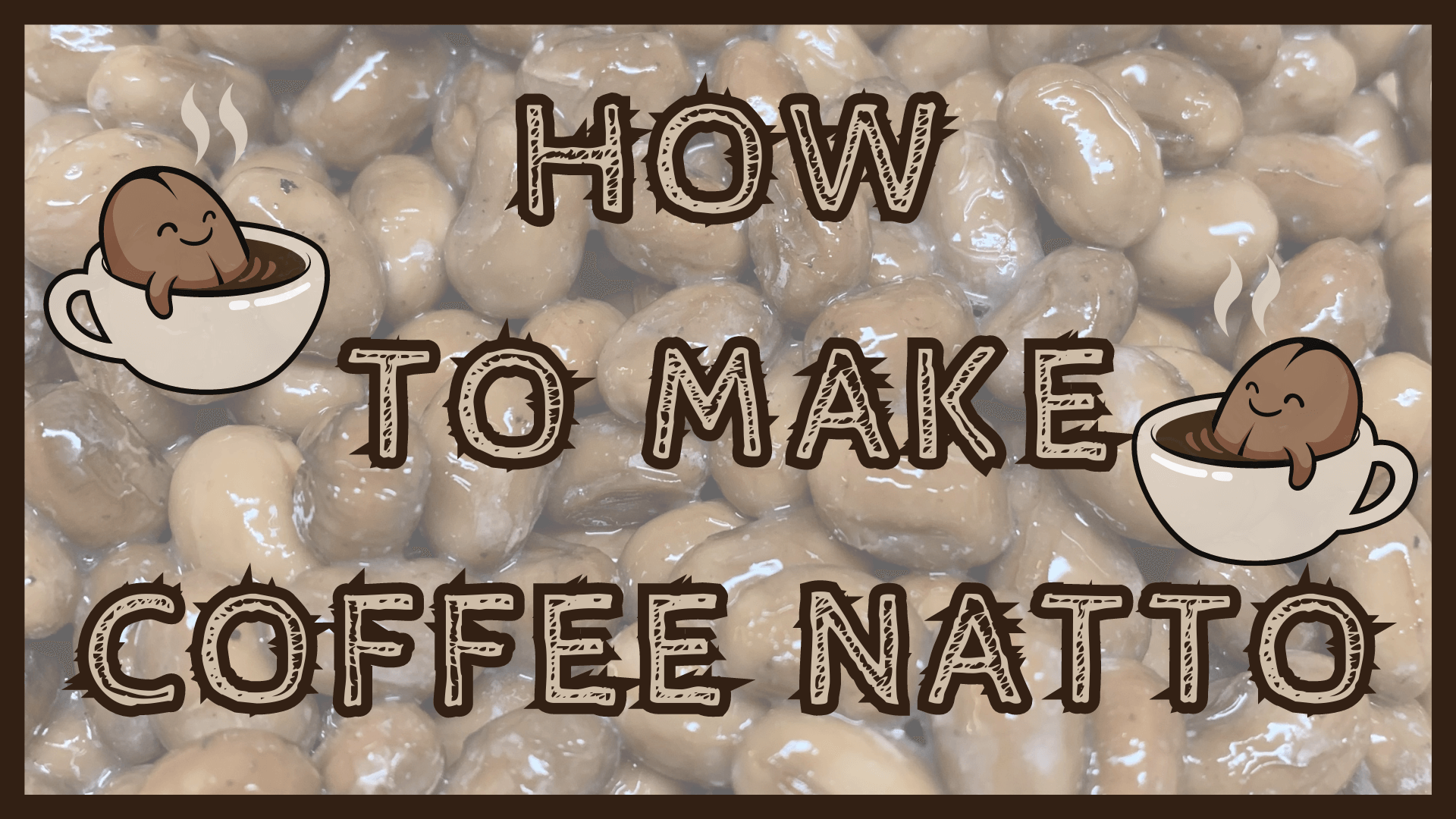- Natto
- Fermented Soybeans
Fermented Soybeans
and their Nutritious Goodness
Fermented soybeans (a.k.a. natto) are full of nutritious goodness and healthy benefits for the heart, cholesterol and blood pressure (1)(2).
They are a Japanese probiotic superfood.
Generally eaten as a topper on rice, natto "packs a micronutrient punch," and it's so high in protein that in Japan it carries the name "field meat" (1).
To teach you about this sticky, stringy powerhouse from Japan I’ve talked with my family and friends here in Japan and visited a museum at a natto factory in Mito, Ibaraki to learn more about fermented soybeans and why they are so packed full of nutrients.
Here are the following questions I set out to answer:
- Why is natto sticky and stringy?
- What turns natto into a micronutrient powerhouse?
- What do these nutritious fermented soybeans look like?
- How do you get natto ready for eating?
- What does natto taste like?
Natto Talk
Want to chat about Japanese fermented soybeans and how you can better enjoy this Japanese superfood?
Subscribe to Natto Talk!
A monthly publication containing info about:
- Things relating to natto
- Simply Natto's "Natto Recipe of the Month"
- Japan and its culture
- Updates made to the Simply Natto website and its social media pages
- Any upcoming product drops or projects
So what are you waiting for?
Fill out the form below and join.
I look forward to sharing my natto journey with you and learning about yours.

Why is natto sticky and stringy?
The stickiness and stringiness of natto comes from the bacterium Bacillus subtilis natto, which is needed for turning boiled soybeans into natto.
While keeping the soybeans at a constant temperature of 40ºC (1) for about 20-24 hours, the bacterium multiplies and creates a sticky, stringy biofilm.
Though it makes these beans appear less appetizing, this protective environment holds various enzymes and produces nutritious benefits that are nothing short of amazing.
What turns natto into a micronutrient powerhouse?
Natto is turned into a micronutrient powerhouse by Bacillus subtilis natto, and one of the various nutrients created by the bacterium is an enzyme called nattokinase.
*Click on "nattokinase" to discover more about this enzyme found in natto.
This enzyme (found in the sticky part of natto) has shown to have potentially useful effects as a blood thinner and it helps in fighting heart disease (1).
Oh, and that's not all the goodness this bacterium provides.
It makes it easier for our bodies to absorb the nutrients of the soybeans, is a probiotic (thank you Bacillus subtilis natto), and it also produces various vitamins and minerals such as K2 and fiber (1)(2).
*Click on "K2" to discover more about the vitamin K2 found in natto.
Thanks to the stickiness and stringiness of these fermented soybeans you get a food that is a micronutrient powerhouse, one that benefits your heart, gut health, brain function, immune system, and even your skin.
Natto Goodness Fact: Bacillus subtilis (or Hay bacillus) is found on the surface of rice straw, as well as in the human body (intestinal tract).
What do these nutritious fermented soybeans look like?
Japanese fermented soybeans are recognizable by their stickiness, their stringiness, or by their earthy fermented smell.
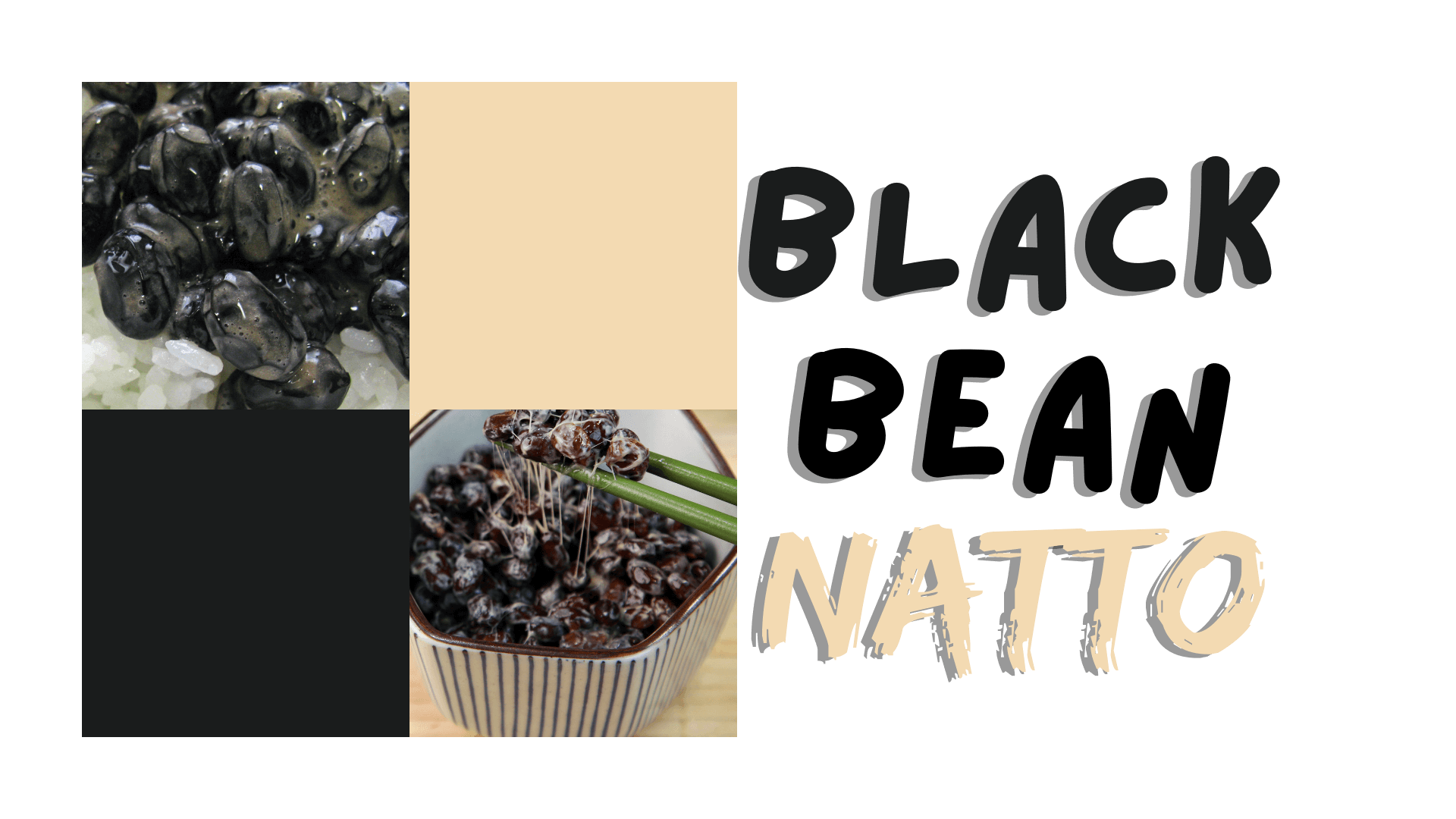 Black Bean "Natto Goodness" with a little Wasabi Kick!
Black Bean "Natto Goodness" with a little Wasabi Kick!Standard natto is a brownish color and the beans are small, however, here in Japan you can also find black beans.
Most natto is served with "karashi" and a “tare” sauce.
Black bean natto is served with a similar sauce and comes with “wasabi."
Yum & Yum!
Simply Natto: Natto Lingo

黒豆
(kuromame)
"coo-row-maw-may"
(slightly roll the "r" in "row")
- black beans
からし
(karashi)
"kaw-raw-she"
(slightly roll the "r" in "raw")
- spicy yellow mustard
タレ
(tare)
"taw-rey"
(slightly roll the "r" in "rey")
- sauce (soy based)
わさび
(wasabi)
"wha-saw-bee"
- Japanese horseradish
How do you get natto ready for eating?
Since natto is stored at 10˚C or below (1) in a package, you'll need to do a few things first before eating these sticky, stringy beans.
Here are some pictures and step-by-step instructions you can use to get your fermented soy beans ready for eating.
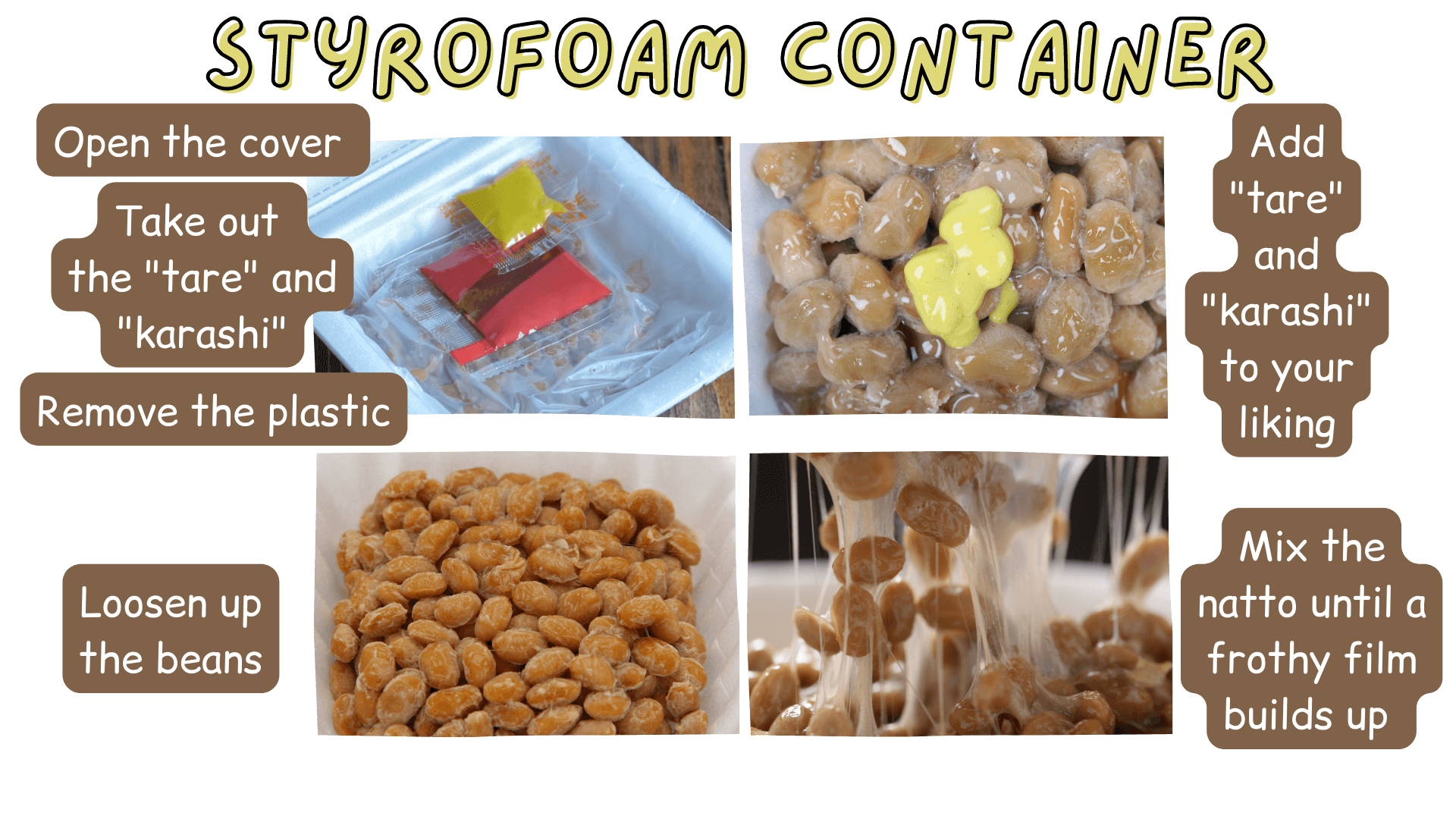 This is the most common way that you find natto packaged and sold in the stores in Japan.
This is the most common way that you find natto packaged and sold in the stores in Japan.- Styrofoam Container
- Open the top cover of the styrofoam box
- Take out the tare and karashi and put if off to the side
- Lift off the plastic film and lay it on the back side of the cover
- Mix the natto around to loosen up the beans
- Add the tare and karashi to your liking
- Continue mixing the natto until a frothy foam builds up around the beans
- Serve on or with your desired dish
Rice Straw
- Remove the outside wrapping
- Open the straw in the middle to expose the beans
- Scoop out beans and put in a bowl
- Mix the natto to loosen up the beans
- Add the tare and karashi to your liking
- Continue mixing the natto until a frothy foam builds up around the beans
- Serve on or with your desired dish
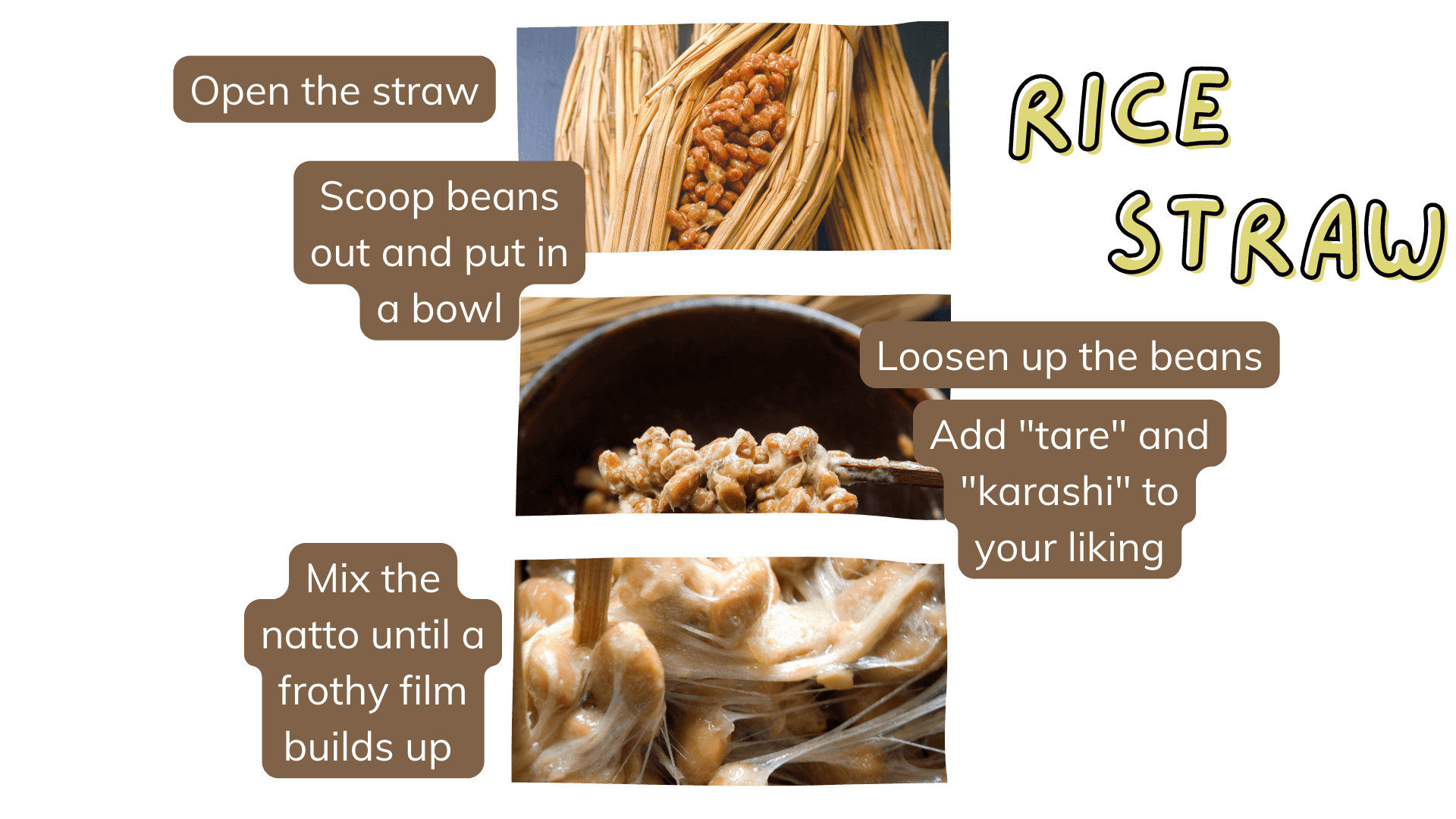 A natural and traditional way that natto is stored and can still be found here in Japan.
A natural and traditional way that natto is stored and can still be found here in Japan. "Natto Goodness" in a Glass Jar
"Natto Goodness" in a Glass Jar- Glass Jar
- Open the lid
- Scoop out the desired amount of natto and put it in a bowl
- Add any condiments (i.e. tare, karashi, ponzu, wasabi) to your liking
- Continue mixing the natto until a frothy foam builds up around the beans
- Serve on or with your desired dish
Natto Goodness Fact: In Japan it is believed that the more you mix your natto, the more delicious the beans will become. Though the number of times is debatable, 20-30 times is generally considered as a sufficient number to release the full flavor of the fermented soybeans.
It's Natto Mixing Time!

What does natto taste like?
Natto has an earthy or nutty flavor that can be strong for some; however, when you mix the beans with different condiments, the flavor can change.
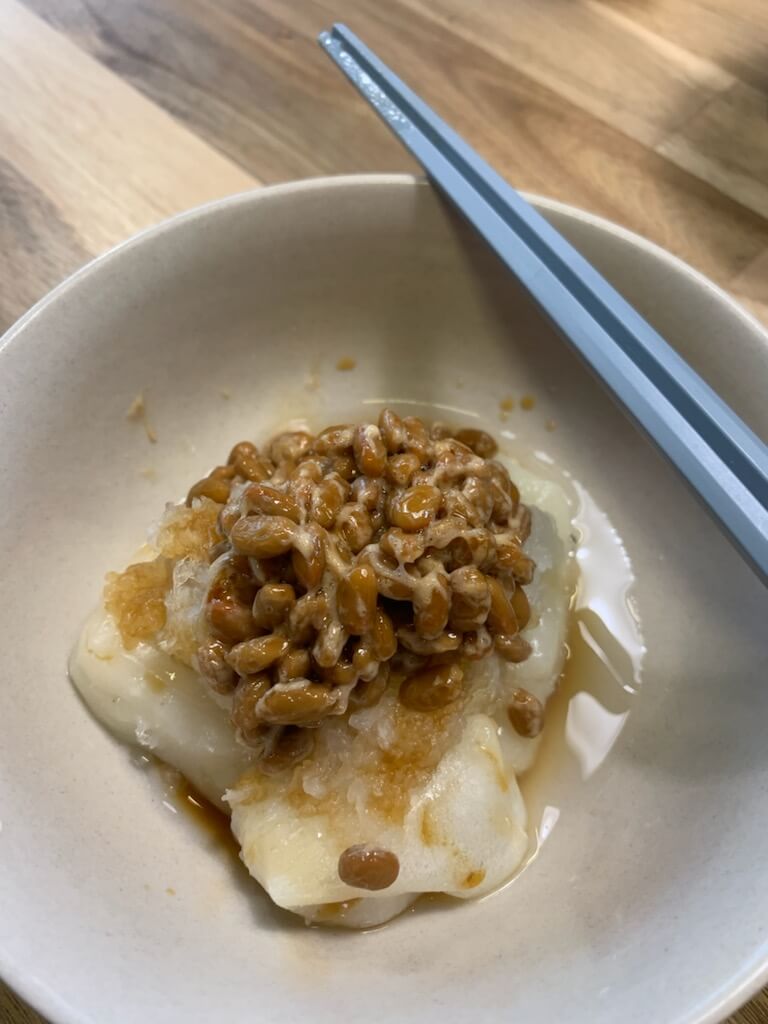 Mochi & "Natto Goodness"
Mochi & "Natto Goodness"Take this simple recipe for example.
- Mix natto with Japanese citrus vinegar.
- Then add freshly grated radish and continue mixing.
- Top this "Natto Goodness" onto your rice, tofu, or mochi and enjoy!
This dish has a light and citrusy flavor, and the fermented smell of the beans is less noticeable.
It's a really refreshing way to enjoy the taste of these sticky, stringy beans.
Here are some other traditional and unique condiment ideas to better enjoy the umami of your natto dish:
- Olive oil
- Amani-yu
- Shoga
- Yuzu-kosho
- Kimchi
- Goma-abura
- Koshou
Try these flavors out separately, or combine them with others, to see which ones suit your palate.
One of my favorite combinations is to use olive oil, a pinch of rock salt, and half of the "tare" that's included with the natto package (no karashi).
Pour the condiments onto your natto and mix them together.
This combination allows you to taste the flavor of the beans while creating a lighter taste that isn't overpowering.
Simply Natto: Natto Lingo

旨味
(umami)
"oo-maw-me"
- flavor
アマニ油
(amani-yu)
"aw-maw-knee-you"
- flaxseed oil
しょうが
(shoga)
"show-gaw"
- ginger
柚子胡椒
(yuzu-kosho)
"you-zoo-coe-show"
- Japanese citrus pepper
ごま油
(goma-abura)
"go-mah-ah-boo-rah"
slightly roll the "r" in "rah"
- sesame oil
胡椒
(koshou)
"coe-show"
- black pepper
What to do next?
Now that you have a better idea of fermented soybeans and why they're a micronutrient powerhouse, it's time for you to start enjoying these sticky, stringy beans too.
Here's a yummy recipe to get you started.
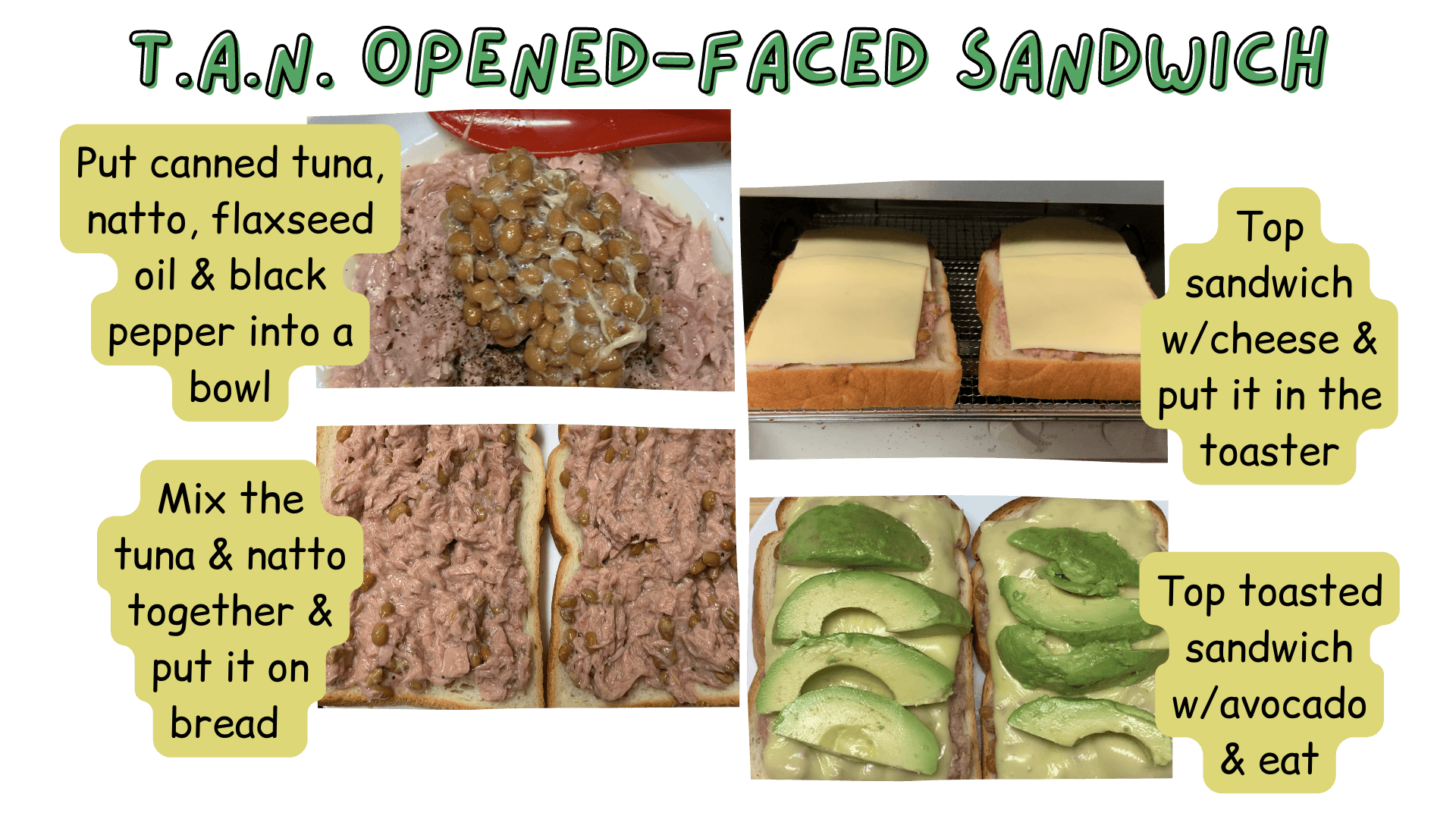 A Delicious Tuna, Avocado, Natto Sandwich!
A Delicious Tuna, Avocado, Natto Sandwich!- T.A.N.
Open-Faced Sandwich
- Put drained canned tuna in a bowl
- Add natto to the bowl of tuna
- Add flaxseed oil & black pepper to your liking
- Mix all the ingredients together
- Put the mixture on bread & top w/cheese
- Put the sandwich into the toaster
- Top the toasted sandwich w/avocado
- Enjoy!
Want to give your palate even more sticky, stringy bean goodness?
Try these traditional and unique recipe ideas to eat and better enjoy the taste of fermented soybeans.
Want to know where natto is eaten in Japan?
Read "Where is Natto Eaten in Japan?" to discover which regions of Japan like and dislike natto, as well as learn which natto toppings are popular.
Keep up with the latest Natto Goodness by following Simply Natto on social media
The Latest Natto Talk
-
Natto Food with Sauces and Spices
Natto food with sauces and spices is a traditional and simple way for you to enjoy natto. It's a great way for you to savor some fermented soybean goodness. -
How to Make Wara Natto
Let's learn how to make wara natto. For centuries, Japanese natto has been made using rice straw, and now you can make it too. -
How to Make Natto with an All-In-One-Pot
Let's learn how to make natto! I'm going to show you how to make your own sticky, stringy beans using an all-in-one-pot. -
How to Make Hojicha Natto
Let's learn how to make hojicha natto! I'm going to teach you how to make your own sticky, stringy beans with a roasted green tea twist in 6 easy steps. -
How to Make Coffee Natto
Let's learn how to make coffee natto! I'm going to teach you how to make your own sticky, stringy beans with a java twist in 6 easy steps.


